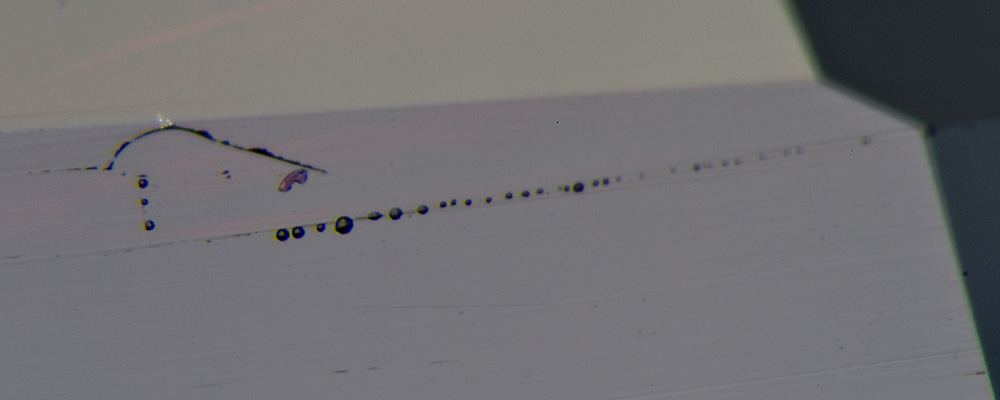Lotus Gemology warns that oiled rubies, sapphires and spinels are entering the Bangkok wholesale market in increasing numbers. Most, but not all, of these gems are originating from Burma.
3 April 2015—Over the past few months gemologists at Bangkok's Lotus Gemology have noticed a disturbing increase in the number of gems submitted for testing that have been subjected to fissure filling with oils/resins. This situation has now reached the stage where a trade warning is in order.
In our opinion, it is not the place for gemologists to decide what is and is not acceptable in terms of treatments. Certainly there is a place in the market for natural, treated, synthetic and imitation stones. That said, we have had a string of clients who, upon being told their stones have been fissure-filled, were visibly displeased. Not a single one was informed about the presence of this treatment at the point of memo or sale.
Standard operating procedure at Lotus Gemology is to ask customers at the time of take-in if they believe their stones are treated, and if so, by what method. Since opening our doors in July 2014, we have not had a single customer declare to us that the ruby, sapphire or spinel they were submitting was filled with oil/resin. In virtually all cases, when we inform the client that the stone is fissure-filled with an oil/resin (on Lotus reports the enhancement code is FF-O, plus levels 1–4 depending on the treatment's impact on appearance), they ask to have the gem back so the filler can be removed.
We believe this speaks volumes, suggesting that at the Bangkok wholesale trade level, both sellers and buyers are unaware their goods have been oil/resin treated. Thus the purpose of this trade alert is to inform buyers so they can make educated decisions. At the same time, we want to inform sellers that they may have a problem with their suppliers, who have not properly informed them of the treatments applied to the gems purchased. Finally, we believe it's important to inform gemologists around the world to be on the lookout for an enhancement that they might not be fully aware of.
In doing so, we will also take this opportunity to describe some of the methods by which fissure filling with oil/resin can be detected. One of our core beliefs is that knowledge belongs to no single company or person, but is the collective property of all humans. Thus we are happy to share the following information on the methodology that we use to detect fissure filling.
The Gems
Lotus Gemology specializes in ruby, sapphire and spinel testing. While we do verbal testing on other gems, we only issue reports on ruby, sapphire and spinel. To date, virtually all of the oil/resin treated gems submitted to Lotus Gemology have been of Burmese origin, with most being rubies.
Burmese rubies are natural candidates for this treatment, since they frequently contain the necessary fissures. However, this treatment is not limited to Burmese rubies. We have seen it applied to Burmese sapphires, Burmese spinels, Burmese tourmalines and, most recently, to Mozambique rubies. Obviously, anything with the requisite fissures can be treated by this method.
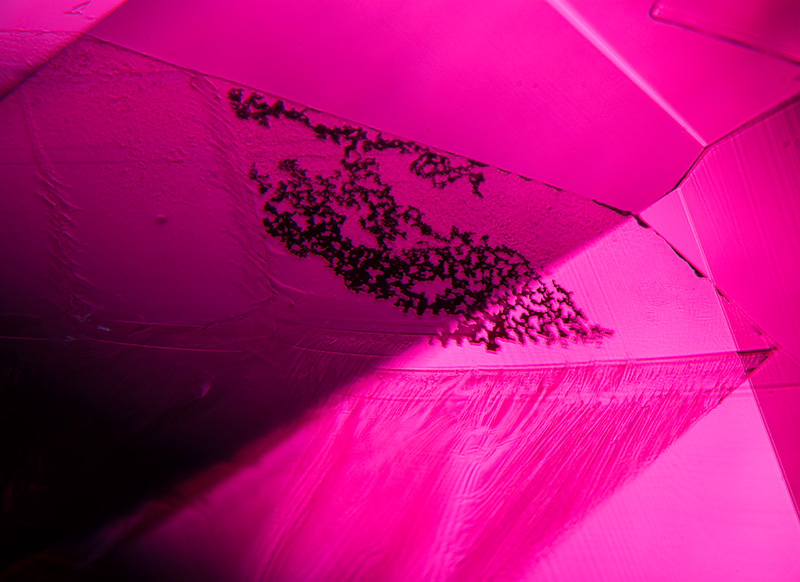 Air bubbles (showing as black) form a dendrite-like pattern within the filled fissure of an oiled spinel from Burma. Oblique dark-field illumination. Photo: Lotus Gemology
Air bubbles (showing as black) form a dendrite-like pattern within the filled fissure of an oiled spinel from Burma. Oblique dark-field illumination. Photo: Lotus Gemology
 Oil droplets leaking out of a surface-reaching fissure in a Burmese spinel, following gentle warming with the hot point. Reflected light. Photo: Lotus Gemology
Oil droplets leaking out of a surface-reaching fissure in a Burmese spinel, following gentle warming with the hot point. Reflected light. Photo: Lotus Gemology
|
Questions on Oiled Gems Is this accidental oiling?Some in the "don't worry, be happy" camp have suggested that this is not deliberate oiling, but simply oil from the cutting/polishing process forced into fissures. Sadly, the evidence to date strongly suggests that this is not the case. First, oil is not commonly used in the cutting process for either ruby, sapphire or spinel. Second, we have seen filled fissures where the filler is so deep that it appears to have been applied via heating/vacuum. While we try to always maintain an open mind, the available evidence strongly suggests that this is being deliberately done to improve the appearance. Could this be water in the fissures from the cutting process?Again, no. Water boils at 100°C and thus even gentle heating with the hot point would quickly vaporize it from fissures. How can you oil a ruby, when the oil's refractive index doesn't match the gem's?This is a misimpression leftover from the Opticon vs. cedarwood debates a couple decades ago. The reality is that replacing air in a fissure with an oil or resin can have a significant effect on appearance, even if the refractive index match between filler and gem is not that close. Consider the following carefully: there is no reason to oil a gem and risk losing a sale, unless the appearance changes in a significant fashion. |
Detection
Gemologists have traditionally used three different techniques to detect fissure fillers in gems, as follows:
FTIR ($25,000+)
The most-often used method is examination of the infrared spectrum (FTIR). Fillers typically show a number of distinctive peaks in the infrared. However, there are problems with this method. The FTIR cannot distinguish between a contaminant on the surface of the gem, relative to the interior. In addition, like all spectroscopic methods, it depends on the beam's path through the filler. If the beam path traverses a long path through the filler, it can create a strong filler signal. Thus the position of the filled fissure or even a filler residue on a surface-reaching cavity can result in a strong filler signal even if the filler has little or no impact on the appearance of the gem.
Micro-Raman ($100,000+)
Another method that is used is to search for areas where the filler leaks out and then test those areas with a microRaman. This method can help to understand what the filler consists of, but it cannot give any clues about the amount of filler present and its impact on the appearance of the gem.
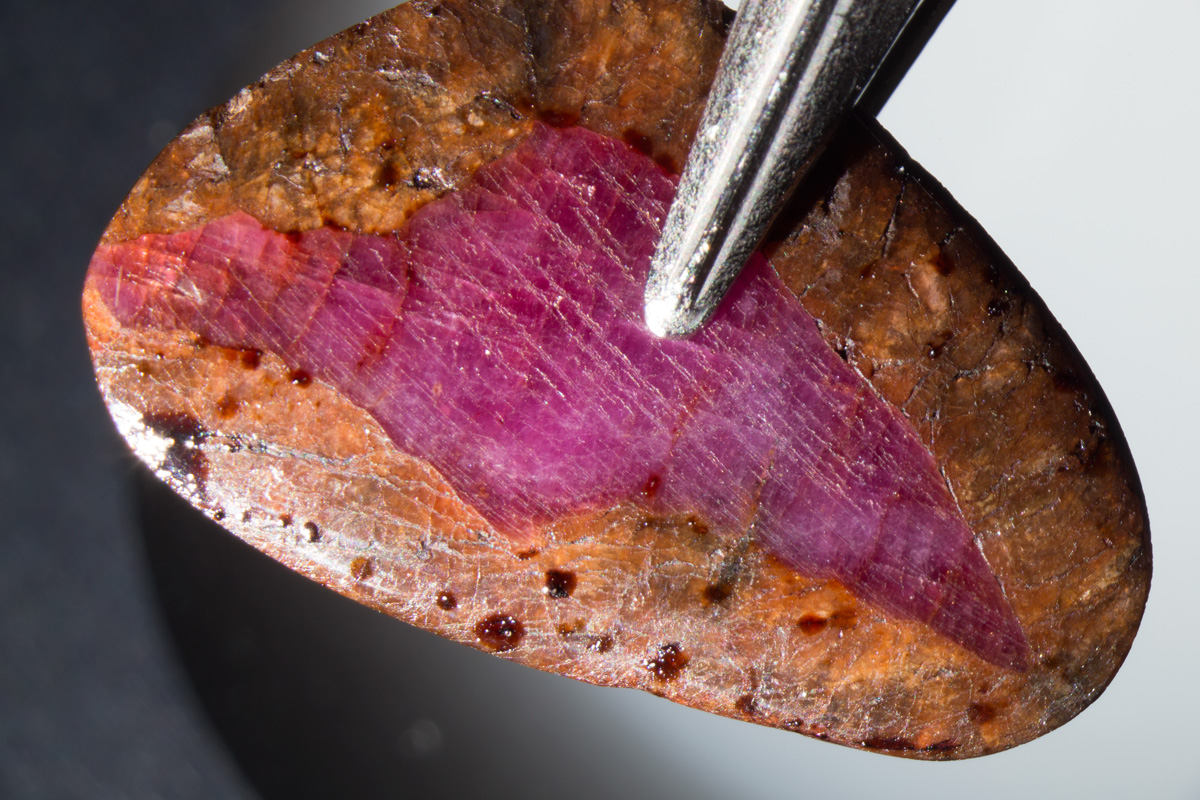 This unusual overgrowth of spinel on ruby from Burma was placed by its owner into an oven and gently heated, causing a brown filler to ooze out of the fissures. Prior to that, Lotus gemologists had identified it as fissure filled via the hot point. Oblique reflected light. Click on the photo for a larger image. Photo: Lotus Gemology
This unusual overgrowth of spinel on ruby from Burma was placed by its owner into an oven and gently heated, causing a brown filler to ooze out of the fissures. Prior to that, Lotus gemologists had identified it as fissure filled via the hot point. Oblique reflected light. Click on the photo for a larger image. Photo: Lotus Gemology
Hot Point ($200 and a $2000 Gemological Microscope)
Mention the hot point to many gemologists and they recoil in fear. "Isn't that a destructive test?" Yes, if you are dealing with plastic or amber and are using the naked eye to observe the reaction. But if you couple the hot point to a microscope, any "damage" will generally be invisible to the naked eye. And if you are applying the hot point to a substance like corundum, spinel or even emerald, the risk of damaging the specimen is extremely small. Indeed, we've been using it on corundums and other gems for more than three decades and have yet to damage a specimen.
The hot point might be the poor stepchild of filler detection, and yet it is extremely powerful. Being a visual method, it suffers from none of the problems of FTIR and microRaman, in that it can identify the presence of a filler in a specific microscopic place within the gem. Thus it is the major technique used by Lotus Gemology to determine if a gem is fissure filled.
Step one is to carefully clean the specimen's surface with an antistatic cloth to remove all surface dust and skin oil. After an exhaustive search that has included everything from European chamois, various flavors of leather and sundry varieties of microfiber "jewelry cleaning" and eyeglass cloths, we have settled on Scotch-Brite brand High Performance antistatic cloths as being the most effective at removing both dust and surface grease.
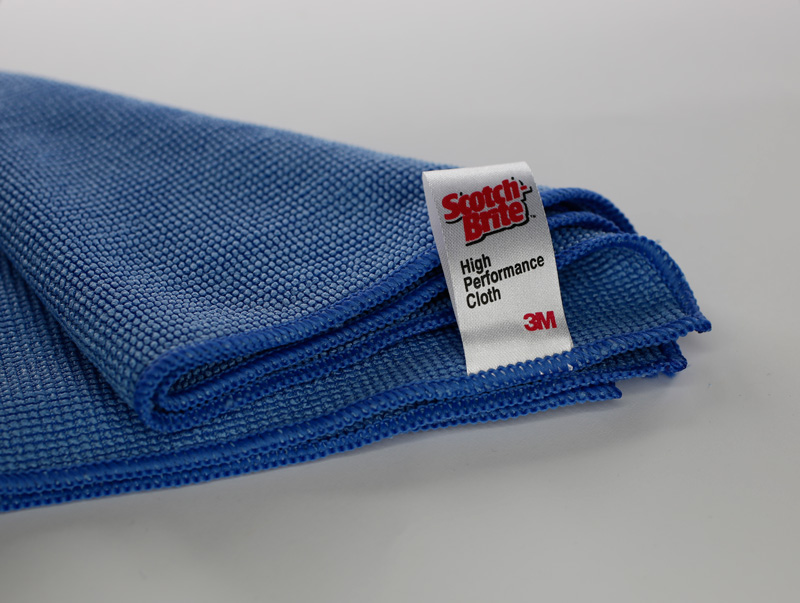 Scotch-Brite High Performance Cloth used for cleaning specimens prior to microscopic examination. Photo: Lotus Gemology
Scotch-Brite High Performance Cloth used for cleaning specimens prior to microscopic examination. Photo: Lotus Gemology
Once the specimen is scrupulously clean, we place the stone in the microscope and examine all fissures in the stone under various lighting conditions (mostly dark field). This is done at magnifications ranging from 20–180x, as needed. We carefully search for surface-reaching fissures for signs of low relief. If a fissure does not reveal high reflectivity, it suggests that it could be artificially filled. The vast majority of filled fissures exhibit air bubbles within the filler. Because these are bubbles within a fluid material (as opposed to a crystalline material), they tend to have rounded edges.
But there are also cases where the surfaces of the fissure have begun to heal and thus their internal surfaces take on more angular edges. In some cases, this is an entirely natural process, which means that the hot point will have no effect whatsoever, since the healed areas around the cavities are the gem themselves.
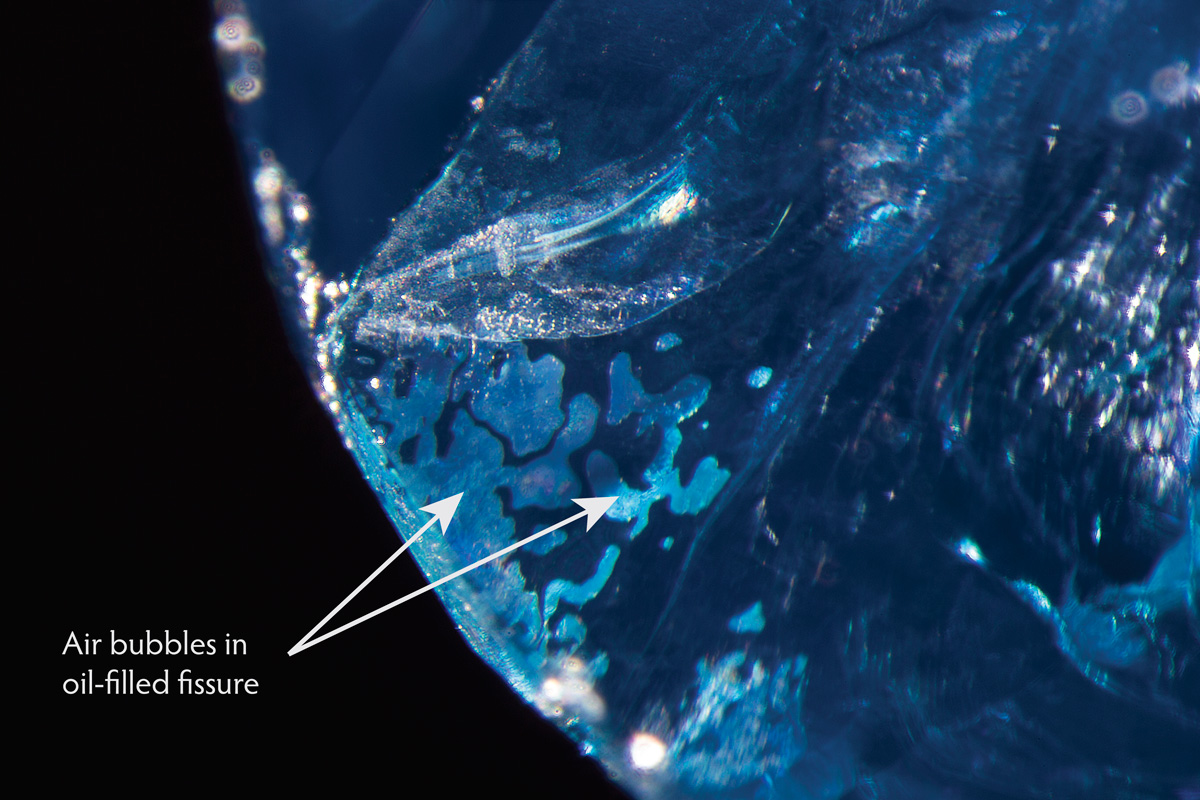 Air bubbles with rounded edges are clearly visible in an oil-filled fissure in an otherwise untreated Burmese sapphire. Because of the low refractive index of the air bubbles, they appear in high relief compared with the surrounding oil and sapphire. Oblique dark-field illumination. Photo: Lotus Gemology
Air bubbles with rounded edges are clearly visible in an oil-filled fissure in an otherwise untreated Burmese sapphire. Because of the low refractive index of the air bubbles, they appear in high relief compared with the surrounding oil and sapphire. Oblique dark-field illumination. Photo: Lotus Gemology
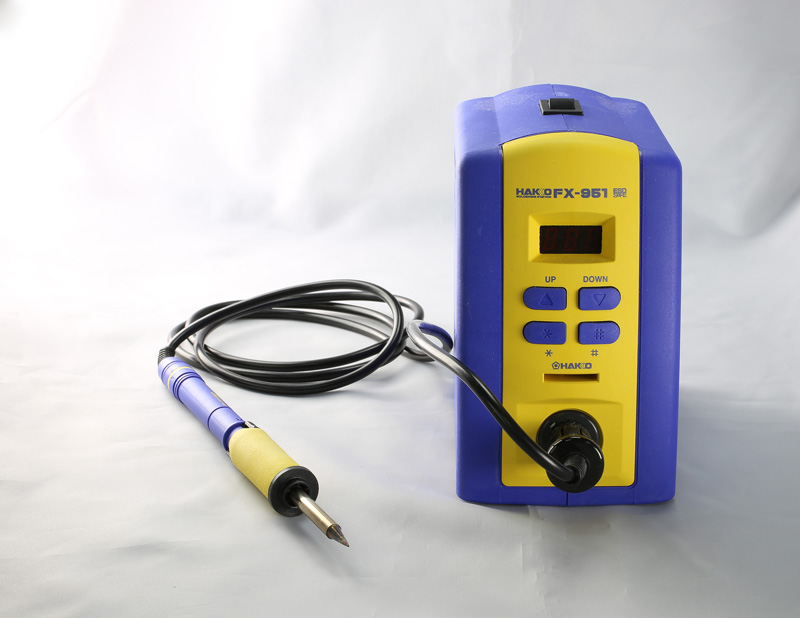 The hot points used by Lotus Gemology are actually soldering irons with the narrowest possible tips. At their highest settings, they reach temperatures of about 400–500°C. Photo: Lotus Gemology
The hot points used by Lotus Gemology are actually soldering irons with the narrowest possible tips. At their highest settings, they reach temperatures of about 400–500°C. Photo: Lotus Gemology
|
video/mp4 In the video above, the hot point is waved over an oil-filled fissure. The dark areas with a somewhat dendritic pattern are air bubbles trapped within the oil. When the filler reaches a high enough temperature, it loses viscosity. As the hot point is stroked across the surface of the stone while viewing with the microscope, the heat causes the air bubbles to contract. Similarly they expand as the hot point moves away. Click the maximize arrow in the bottom right corner to blow the video up to full screen, where the effect becomes quite obvious. Video: Lotus Gemology |
video/mp4
In many cases, even the heat of the microscope lamp itself will cause an oiled gem to leak. But please note that the LED illuminators used in some microscopes today do not generate enough heat to produce this reaction. Quartz-halogen illumination does.Similar to the first video, the hot point is waved over an oil-filled fissure. The dark areas with a somewhat dendritic pattern are air bubbles trapped within the oil. When the filler reaches a high enough temperature, it loses viscosity. As the hot point is stroked across the surface of the stone while viewing with the microscope, the heat causes the air bubbles to contract and expand. Click the maximize arrow in the bottom right corner to blow the video up to full screen, where the effect becomes quite obvious. Video: Lotus Gemology
The above video shows the reaction of an air bubble in an oil-filled fissure in a cuprian tourmaline as the hot point is moved closer and farther from the fissure.
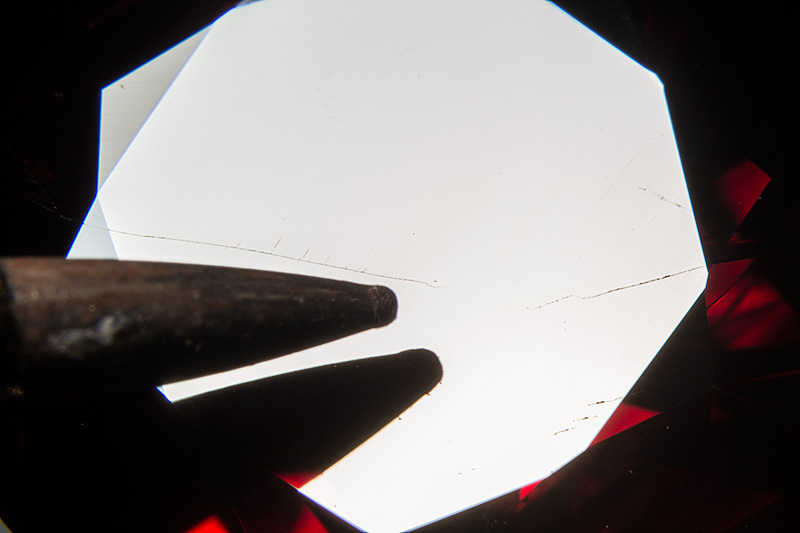 The tip of the hot point is placed onto the surface of a ruby. In reflected light, the surface-reaching fissures are obvious. Reflected light. Photo: Richard W. Hughes
The tip of the hot point is placed onto the surface of a ruby. In reflected light, the surface-reaching fissures are obvious. Reflected light. Photo: Richard W. Hughes
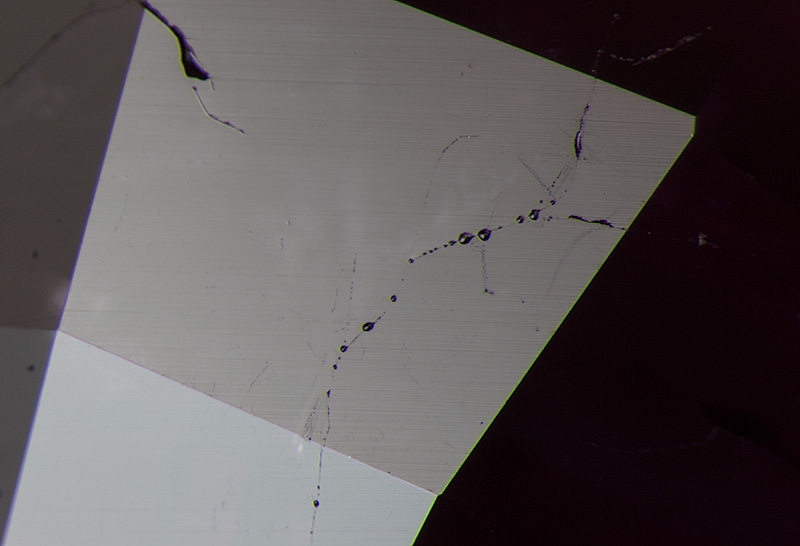 Oil coagulating on the surface of a Burmese ruby after gentle heating with the hot point. Note how the oil droplets follow the fissure opening. Reflected light. Photo: Lotus Gemology
Oil coagulating on the surface of a Burmese ruby after gentle heating with the hot point. Note how the oil droplets follow the fissure opening. Reflected light. Photo: Lotus Gemology
Conclusion
Judging from the reactions of our clients when informed that their rubies, sapphires and spinels have been subjected to oiling, this is not a "traditional" enhancement method, but rather a form of fraud, since none of them have been informed of, or expected their gems to be treated in this way. We have seen a number of stones that, upon removal of the filler, have shown significant deterioration in appearance. In certain cases, substantial amounts of money ride on the presence or absence of the filler. Thus we believe that it is imperative that the trade deals with this threat as quickly as possible.

About Lotus Gemology
Founded in 2014, Bangkok's Lotus Gemology operates from a base of over seventy years of collective experience in the study, purchase, sale and appreciation of precious stones. Lotus gemologists have authored a number of books and over 180 papers relating to gemology and the gem trade and have won numerous industry awards. Their latest books are Ruby & Sapphire: A Collector's Guide (2014), Ruby & Sapphire: A Gemologist's Guide (2017), and Inside Out: GEM•ology Through Lotus-Colored Glasses.
Further Reading
- Tay Thye Sun & Loke Hui Yin (2014) Oiling of star rubies from Burma. IGCL Newsletter, No. 2, Spring, p. 1.

